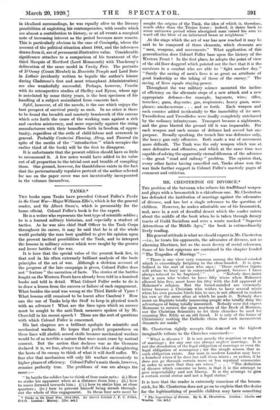A COMPLETE BEACONSFIELD *
THE progressive veering round of taste through a phase of barbaric formlessness towards a revival of Victorian ideals
brings as an almost inevitable corollary the reissue of Disraeli's novels in the first complete edition which has been put into the hands of the public. It is not too much to say that for the younger generation Disraeli is to all intents and purposes a new novelist, to be approached with the same sense of strangeness and slightly patronizing curiosity inspired by twisted mahogany pilasters and horsehair upholstery. Whether, in spite of his exuberant vitality and the gusto with which he identifies himself with his characters, the young intellectuals of our day will ever succeed in accepting his florid effervescence, and in pardoning the unerring instinct with which he lavishes superlatives on second-rate art—the Caraccis, Caravaggio, and the late six- teenth-century school in general : Meyerbeer, Donizetti, Rossini, and Mendelssohn in music (all characteristically claimed as Jews)—is a somewhat difficult matter to forecast.
Another typical feature which is of a nature to estrange the modern reader is the complacent indebtedness of his heroes—
a touch of pure autobiography, of course—to the fortunes of their respective wives, who, by the amending touch of fiction, are represented as invariably young and beautiful. It is Hen• rietta Temple's wealth that saves the situation for Amine ; Coningsby not only marries money, but inherits it from another
woman ; while Egremont divides his obligation between Sybil and his brother. Endymion is. another example of the same
thing. None of his heroes owes more than the latter to feminine influence and help. The usefulness of women is, in fact, Dis- raeli's favourite theme, and although, it is true, he did not himself enjoy the stupendous luck of his heroes, his political career was only rendered possible by the modest wealth of his wife, followed at a later stage by the large bequest of Mrs.
Brydges Williams.
Few novelists, indeed, have drawn more frankly in their work
on their own personal experience. As he writes in his Diary in 1834: " My works are the embodification of my feelings. In Vivian Grey I have portrayed my active and real ambition ; in Alroy my ideal ambition. The Psychological Romance [Contarini Fleming] is a development of my poetic character. This trilogy is the secret history of my feelings—I shall write no more about myself."
This decision, however, although it held good for some years, was afterwards revoked. Not only was the love-story of Hen• rielta Temple begun during an affair with a real Henrietta and completed after a final parting, but with Coningsby (professedly drawn from George Smythe) the author's own personality
reappears as protagonist, and Endymion, written and published just before his death in 1881, describes another brilliant young Disraeli under fairy-tale conditions.
Yet fancy could hardly invent a more astounding success of impudence than the episode in his own career described in Vivian Grey, where the young hero, without credentials, plays on the vanity of the effete Marquis of Carabas and inspires him with the idea that the Premiership is within his grasp. In this instance fact outstripped imagination, for the incident on whicl it was founded was Disraeli's experience at the age of twenty in the autumn of 1825, when he encouraged Murray, the mos: sagacious publisher of the day, in the supposition that he might found a newspaper to rival the Times, and was accordingly despatched to interview Sir Walter Scott and Lockhart at Abbotsford, with the mission of securing the latter as editor, just as in the novel Vivian visits Cleveland in the interest of Carabas.
If Disraeli showed no hesitation in staging himself as hero
• Novels and Tales. By the Bari of Beaconsfield. London . Longman, FAB. 8d. net per voLl
in idealized surroundings, he was equally alive to the literary possibilities of exploiting his contemporaries, with results which are almost a contribution to history, or at all events a marginal note of increasing interest as the period becomes more remote. This is particularly obvious in the case of Coningsby, where the account of the political situation about 1844, and the inferences drawn from it, are of permanent illustrative value. Considerable significance attaches to a comparison of his treatment of the third Marquis of Hertford (Lord Monmouth) with Thackeray's delineation of the same model in Vanity Fair. The portraits of D'Orsay (Count Mirabel) in Henrietta Temple and Lord Bute in Lothair (evidently written to beguile the author's leisure during Gladstone's first and most triumphant Administration) are also wonderfully successful. Perhaps, however, Venetia with its retrospective studies of Shelley and Byron, whose age is antedated by some thirty years, is the best specimen of his handling of a subject assimilated from concrete fact.
Sybil, however, of all the novels, is the one which enjoys the best prospect of survival purely as such. In no other is there to be found the breadth and masterly brushwork of this canvas which sets forth the cause of the working man against a rich and careless aristocracy, and more especially against the rising manufacturers with their boundless faith in freedom of oppor- tunity, regardless of the evils of child-labour and overwork in general. Probably Contarini Fleming, Alroy, and Tancred (in spite of the merits of the " introduction " which occupies the earlier third of the book) will be the first to disappear.
It is unfortunate that the present edition should have so little to recommend it. A few notes would have added to its value out of all proportion to the trivial cost and trouble of compiling them. One ground, however, for thankfulness exists in the fact that the preternaturally repulsive portrait of the author selected for use on the paper cover was not inextricably incorporated in the volumes themselves.





































 Previous page
Previous page